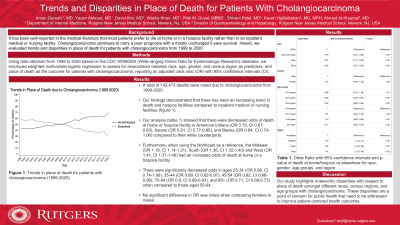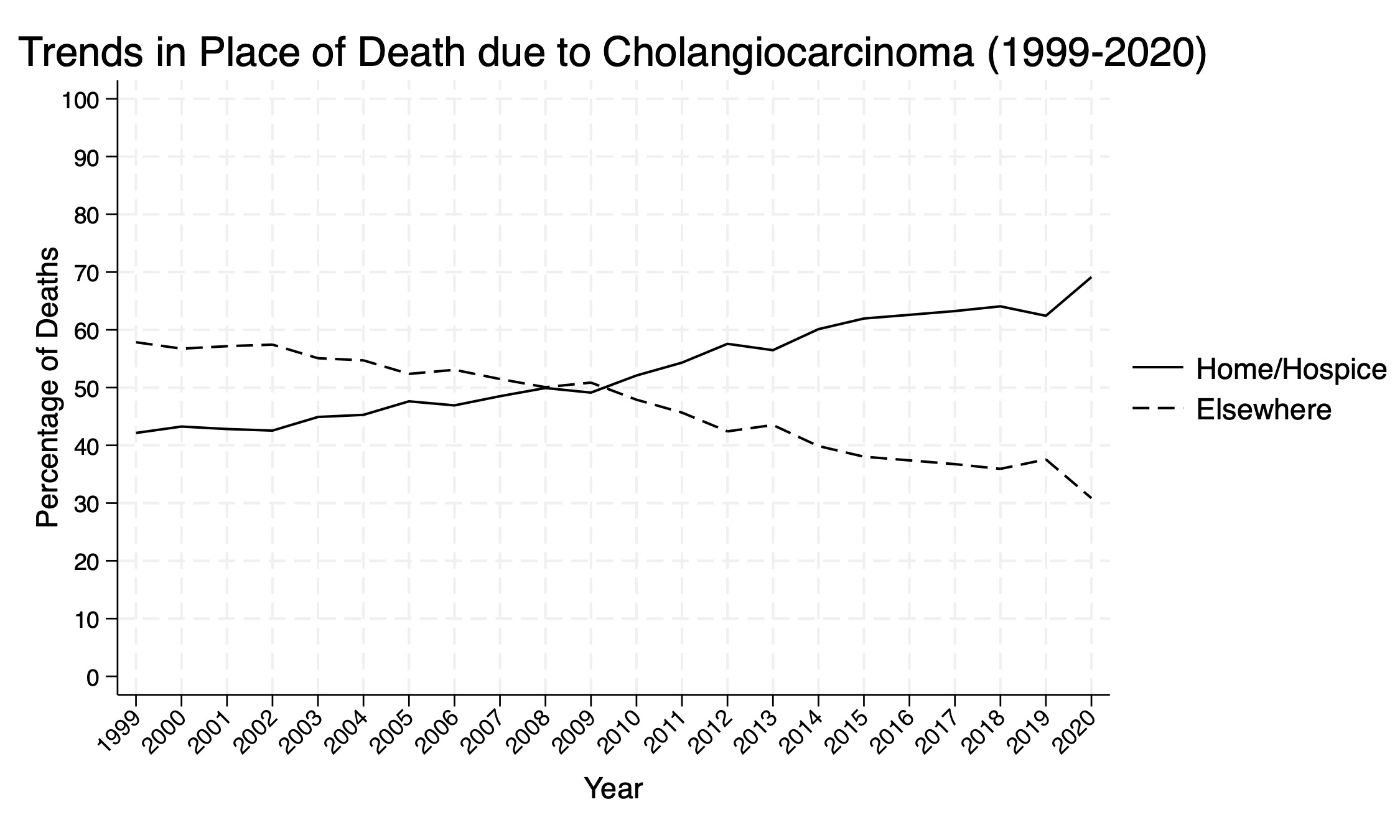Tuesday Poster Session
Category: Biliary/Pancreas
P3488 - Trends and Disparities in Place of Death for Patients With Cholangiocarcinoma
Tuesday, October 29, 2024
10:30 AM - 4:00 PM ET
Location: Exhibit Hall E

Has Audio

Imran A. Qureshi, MD
Rutgers New Jersey Medical School
Newark, NJ
Presenting Author(s)
Imran Qureshi, MD, Yazan Abboud, MD, David Kim, MD, Wajiha Khan, MD, Ritik M. Goyal, MBBS, Shivani Patel, MD, Kaveh Hajifathalian, MD, Ahmed Al-Khazraji, MD
Rutgers New Jersey Medical School, Newark, NJ
Introduction: It has been well-reported in the medical literature that most patients prefer to die at home or in a hospice facility rather than in an inpatient medical or nursing facility (1). Cholangiocarcinoma continues to carry a poor prognosis with a mostly unchanged 5-year survival (2). Herein, we evaluated trends and disparities in place of death for patients with cholangiocarcinoma from 1999 to 2020.
Methods: Using data obtained from 1999 to 2020 based on the CDC WONDER (Wide-ranging Online Data for Epidemiologic Research) database, we employed weighted multivariate logistic regression to assess for associations between race, age, gender, and census region as predictors, and place of death as the outcome for patients with cholangiocarcinoma, reporting an adjusted odds ratio (OR) with 95% confidence intervals (CI).
Results: A total of 142,473 deaths were noted due to cholangio carcinoma from 1999-2020. Our findings demonstrated that there has been an increasing trend in death and hospice facilities compared to inpatient medical or nursing facilities (figure 1). Our analysis (table 1) showed that there were decreased odds of death at home or hospice facility in American Indians (OR 0.79, CI 0.67-0.93), Asians (OR 0.81, CI 0.77-0.85), and Blacks (OR 0.64, CI 0.74-1.06) compared to their white counterparts. Furthermore, when using the Northeast as a reference, the Midwest (OR 1.18, CI 1.14-1.21), South (OR 1.36, CI 1.32-1.40) and West (OR 1.41, CI 1.37-1.46) had an increased odds of death at home or a hospice facility. There were significantly decreased odds in ages 25-34 (OR 0.88, CI 0.74-1.06), 35-44 (OR 0.89, CI 0.82-0.97), 45-54 (OR 0.92, CI 0.88-0.96), 75-84 (OR 0.9, CI 0.88-0.93), and 85+ (OR 0.71, CI 0.68-0.73) when compared to those aged 55-64. No significant difference in OR was noted when comparing females to males.
Discussion: Our study highlights noteworthy disparities with respect to place of death amongst different races, census regions, and age groups with cholangiocarcinoma. These disparities are a point of concern for public health that need to be addressed to improve patient-centered health outcomes.
References:
1. Gomes B, Calanzani N, Gysels M, Hall S, Higginson IJ. Heterogeneity and changes in preferences for dying at home: a systematic review. BMC Palliat Care. 2013 Feb 15;12:7
2. Mosconi S, Beretta GD, Labianca R, Zampino MG, Gatta G, Heinemann V. Cholangiocarcinoma. Crit Rev Oncol Hematol. 2009 Mar;69(3):259-70

Note: The table for this abstract can be viewed in the ePoster Gallery section of the ACG 2024 ePoster Site or in The American Journal of Gastroenterology's abstract supplement issue, both of which will be available starting October 27, 2024.
Disclosures:
Imran Qureshi, MD, Yazan Abboud, MD, David Kim, MD, Wajiha Khan, MD, Ritik M. Goyal, MBBS, Shivani Patel, MD, Kaveh Hajifathalian, MD, Ahmed Al-Khazraji, MD. P3488 - Trends and Disparities in Place of Death for Patients With Cholangiocarcinoma, ACG 2024 Annual Scientific Meeting Abstracts. Philadelphia, PA: American College of Gastroenterology.
Rutgers New Jersey Medical School, Newark, NJ
Introduction: It has been well-reported in the medical literature that most patients prefer to die at home or in a hospice facility rather than in an inpatient medical or nursing facility (1). Cholangiocarcinoma continues to carry a poor prognosis with a mostly unchanged 5-year survival (2). Herein, we evaluated trends and disparities in place of death for patients with cholangiocarcinoma from 1999 to 2020.
Methods: Using data obtained from 1999 to 2020 based on the CDC WONDER (Wide-ranging Online Data for Epidemiologic Research) database, we employed weighted multivariate logistic regression to assess for associations between race, age, gender, and census region as predictors, and place of death as the outcome for patients with cholangiocarcinoma, reporting an adjusted odds ratio (OR) with 95% confidence intervals (CI).
Results: A total of 142,473 deaths were noted due to cholangio carcinoma from 1999-2020. Our findings demonstrated that there has been an increasing trend in death and hospice facilities compared to inpatient medical or nursing facilities (figure 1). Our analysis (table 1) showed that there were decreased odds of death at home or hospice facility in American Indians (OR 0.79, CI 0.67-0.93), Asians (OR 0.81, CI 0.77-0.85), and Blacks (OR 0.64, CI 0.74-1.06) compared to their white counterparts. Furthermore, when using the Northeast as a reference, the Midwest (OR 1.18, CI 1.14-1.21), South (OR 1.36, CI 1.32-1.40) and West (OR 1.41, CI 1.37-1.46) had an increased odds of death at home or a hospice facility. There were significantly decreased odds in ages 25-34 (OR 0.88, CI 0.74-1.06), 35-44 (OR 0.89, CI 0.82-0.97), 45-54 (OR 0.92, CI 0.88-0.96), 75-84 (OR 0.9, CI 0.88-0.93), and 85+ (OR 0.71, CI 0.68-0.73) when compared to those aged 55-64. No significant difference in OR was noted when comparing females to males.
Discussion: Our study highlights noteworthy disparities with respect to place of death amongst different races, census regions, and age groups with cholangiocarcinoma. These disparities are a point of concern for public health that need to be addressed to improve patient-centered health outcomes.
References:
1. Gomes B, Calanzani N, Gysels M, Hall S, Higginson IJ. Heterogeneity and changes in preferences for dying at home: a systematic review. BMC Palliat Care. 2013 Feb 15;12:7
2. Mosconi S, Beretta GD, Labianca R, Zampino MG, Gatta G, Heinemann V. Cholangiocarcinoma. Crit Rev Oncol Hematol. 2009 Mar;69(3):259-70

Figure: Figure 1: Trends in place of death for patients with cholangiocarcinoma (1999-2020)
Note: The table for this abstract can be viewed in the ePoster Gallery section of the ACG 2024 ePoster Site or in The American Journal of Gastroenterology's abstract supplement issue, both of which will be available starting October 27, 2024.
Disclosures:
Imran Qureshi indicated no relevant financial relationships.
Yazan Abboud indicated no relevant financial relationships.
David Kim indicated no relevant financial relationships.
Wajiha Khan indicated no relevant financial relationships.
Ritik Goyal indicated no relevant financial relationships.
Shivani Patel indicated no relevant financial relationships.
Kaveh Hajifathalian indicated no relevant financial relationships.
Ahmed Al-Khazraji indicated no relevant financial relationships.
Imran Qureshi, MD, Yazan Abboud, MD, David Kim, MD, Wajiha Khan, MD, Ritik M. Goyal, MBBS, Shivani Patel, MD, Kaveh Hajifathalian, MD, Ahmed Al-Khazraji, MD. P3488 - Trends and Disparities in Place of Death for Patients With Cholangiocarcinoma, ACG 2024 Annual Scientific Meeting Abstracts. Philadelphia, PA: American College of Gastroenterology.
